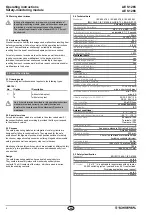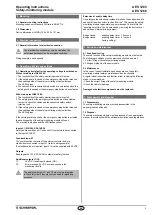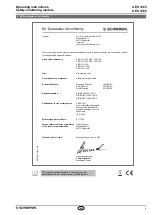
4
Operating instructions
Safety-monitoring module
AES 1265
AES 1266
EN
8. Appendix
8.1 Wiring examples
The application examples shown are suggestions. They however do
not release the user from carefully checking whether the switchgear
and its set-up are suitable for the individual application.
The wiring diagram is shown with guard doors closed and in a de-
energised condition. Inductive loads (e.g. contactors, relays, etc.)
are to be provided with suitable interference suppression circuitry.
Do not connect additional loads to terminal S..
AES 1265/1266
Monitoring of two safety guards with two position switches
with safety function.
AES 1265
14
L1
A1
K1
K3
S13
max.
S14
X1
K4
3
K2
S22
13
+24 VDC
0 V
N
M
23
24
S22
Y1
A2
A1
A2
Y2
S14
B
A
S1
S2
Key
A
Positive break
H
Start button
A + B
S
Non-contact safety sensor
8.2 Integral System Diagnostics (ISD)
The safety monitoring modules LED display to show the different
switching conditions and faults. The following tables show the different
switching conditions.
Tables switching condition indication
Diagnostic LED
System condition
The LED is green.
Enabling paths closed
LED flashes yellow (0.5 Hz) Enabling paths open
LED flashes yellow (2 Hz)
Safety guard closed, however no
authorised operation; possible cause:
incorrect operation (only one contact
was actuated when the safety guard
was opened) or voltage drop or
feedback loop not closed
→ perform start-up test
AES 1265 / 1266 with two additional LED indications.
Indication (yellow) LED
System condition
1 impulse
Safety guard 1 open
2 impulses
Safety guard 2 open
Table error indications
Indication (orange)
LED
Error
Cause
1 impulse
Inputs S1
Defective supply
voltage lead, defective
switch, erroneous fitting
of the switch; switch
only partially actuated*
for at least 5 s
2 impulses
Inputs S2
refer to errors inputs
S1
3 impulses
Inputs
S1 and S2
refer to errors inputs
S1
4 impulses
Interference signals
at the inputs (no
safe evaluation
assured)
Too high capacitive or
inductive interference
at the switch's cables
or the supply voltage
lead
5 impulses
One or both relays
did not close within
the monitoring time
Too low operating
voltage U
e;
Defective relay
6 impulses
Relay not disabled
upon the actuation
of the switch
Welded relay contact
7 impulses
Dynamic monitoring
of both channels
(cross-monitoring)
failure
Fault in one
channel; internal
data transmission
interrupted
* Partial actuation: position of the switch, in which only one contact was actuated.
Deleting the error message
The error message is deleted once the fault has been rectified and after
the connected switch has been actuated to check the various functions
(open and then close the safety guard).
























